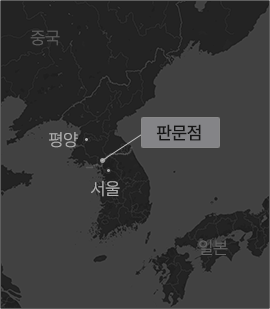
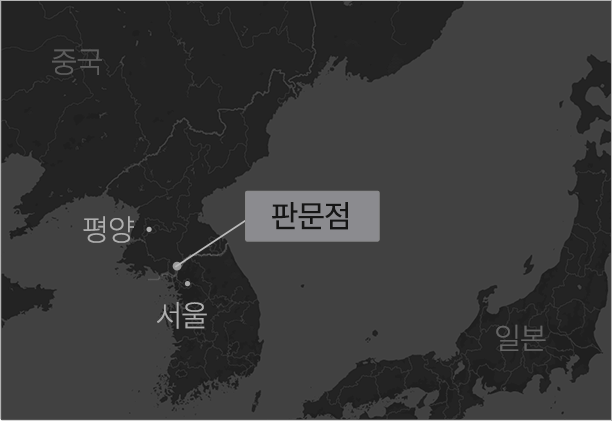
Panmunjom is a product of the Korean War and has been a symbol of the armistice system for the past 65 years. It was originally a small village called “Neolmun-ri”, where only four thatched cottages were nestled in. The name “Panmunjom” was originally how the Communist Chinese army participating in the armistice talks referred to a tavern in Neolmun-ri in Chinese characters. The official name is the Joint Security Area, or JSA.
A month later, on May 26, a closed inter-Korean summit was held at the Tongil-Gak, north side of Panmunjom. It was the fourth summit in history and the second summit for present government. A working-level negotiation on the first North American summit meeting in Singapore was also held at Panmunjom. High-ranking inter-Korean talks and Red Cross talks for family reunions will also be held here. Will ‘Panmunjom’, the symbol of division in 65 years, be reborn as a symbol of peace on the Korean Peninsula?
Spring is Here
2018 The third inter-Korean summit
On April 27th, at 9:29,“hermit leader” Kim Jong-un walked across the 5 centimeter-high military demarcation line between Panmunjom T2 (the Military Armistice Commission main conference room) and T3 (the MAC’s small meeting room) buildings.
The two leaders walked on a red carpet to Peace House, where the summit was to take place and reviewed the South Korean guard of honor, which was also the first time ever for a North Korean leader. Right after reviewing the honor guard, the leaders spontaneously took group pictures with their aides from both sides, although it had not been planned.
After the morning meeting ended on the 2nd floor, the two leaders had lunch separately. During this time Kim Jong-un returned to the North Korean side and came back. On the “Road of the Cows” (the path that Hyundai chairman Chung went through to bring cows to North Korea) next to the T3 building, he and President Moon planted a tree in commemoration of their meeting. It was a pine tree from the year 1953 when the armistice was signed. For planting, soils from Mt. Halla and Mt. Baekdu were used, symbolizing the wish to heal the wounds of the past 65 years. They poured water from Han River and Taedong River onto the tree as well. Near the tree, a monument that said, “We planted peace and prosperity” was erected.
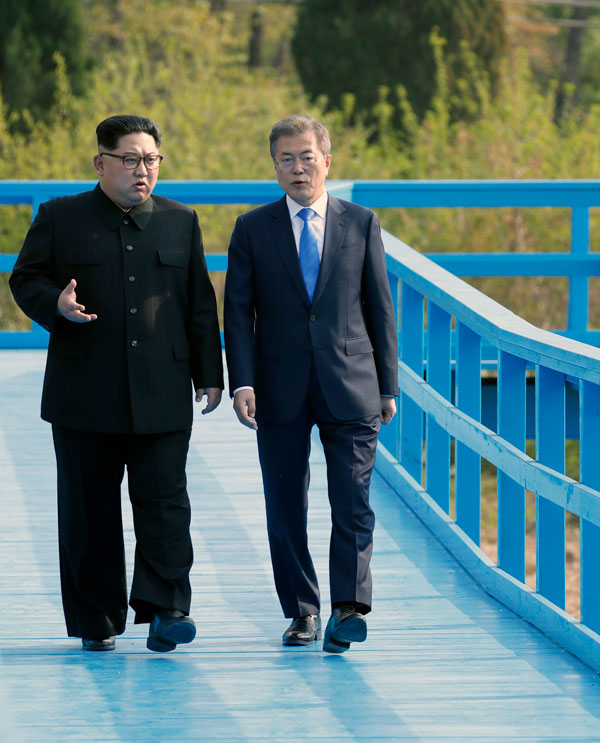
The two leaders talked by themselves on a footbridge for 40 minutes without any other attendees. It was an old bridge that the U.N. Command used to call “Foot Bridge” and was repaired specifically for this summit. The two leaders sitting close together and having a conversation were filmed from a distance and only the scene without sound was aired live. The scene was found by many to be symbolic, like “the quiet spring” that had arrived on the Korean peninsula.
After the meeting in the afternoon, the two leaders released the “Panmunjom Declaration for Peace, Prosperity and Reunification of the Korean Peninsula”, which solemnly avows that there will no longer be war in the Korean peninsula and a new era of peace will begin. The two Koreas announced that they would prepare the path for ending the war and denuclearizing the peninsula based on the 3 provisions and 13 items in the agreement.
After the declaration, a welcome banquet was held on the 3rd floor of Peace House, where Kim Jong-un and his wife Ri Sol-ju, South Korean singers Cho Yong-pil and Yoon Do-hyun, and North Korean Orchestra director Hyon Song-wol all attended. After the banquet, Kim and his wife watched “One Spring”, a farewell performance held in the front yard of Peace House before they returned to the north side.
Spring is Here

Fourth closed South-North summit
On May 26, at 3 pm, President Moon Jae-in and Kim Jung-eunmet again at the summit month. The place was also Panmunjom. US President Donald Trump has said he will cancel the North American summit scheduled for June 12th. The second round of talks took place quickly afterKim`s proposal (25th) that “I would like to meet without any formalities”. The place was Tongil-Gak, north side of Panmunjom.
The meeting, which was closed to the public, omits all of the welcome events. North Korean leader Kim Jong Eun‘s younger sister, Kim Young-jung, the first deputy head of the Central Committee of the Labor Party, welcomed the President Moon. The talks were held for a total of two hours. Only the South Korean government head of information, Seo-Hun and director of the Unified Front Kim Young-chul were attended. The two leaders hugged each other three times after the meeting.
The president Moon unveiled the summit two hours and fifty minutes after the talks, and the agreement was released the next day at the request of the North. The main focus of the summit was to cooperate for the successful hosting of the the North American summitt, and to promote high-level inter-Korean talks on June 1 and reunions of separated families.
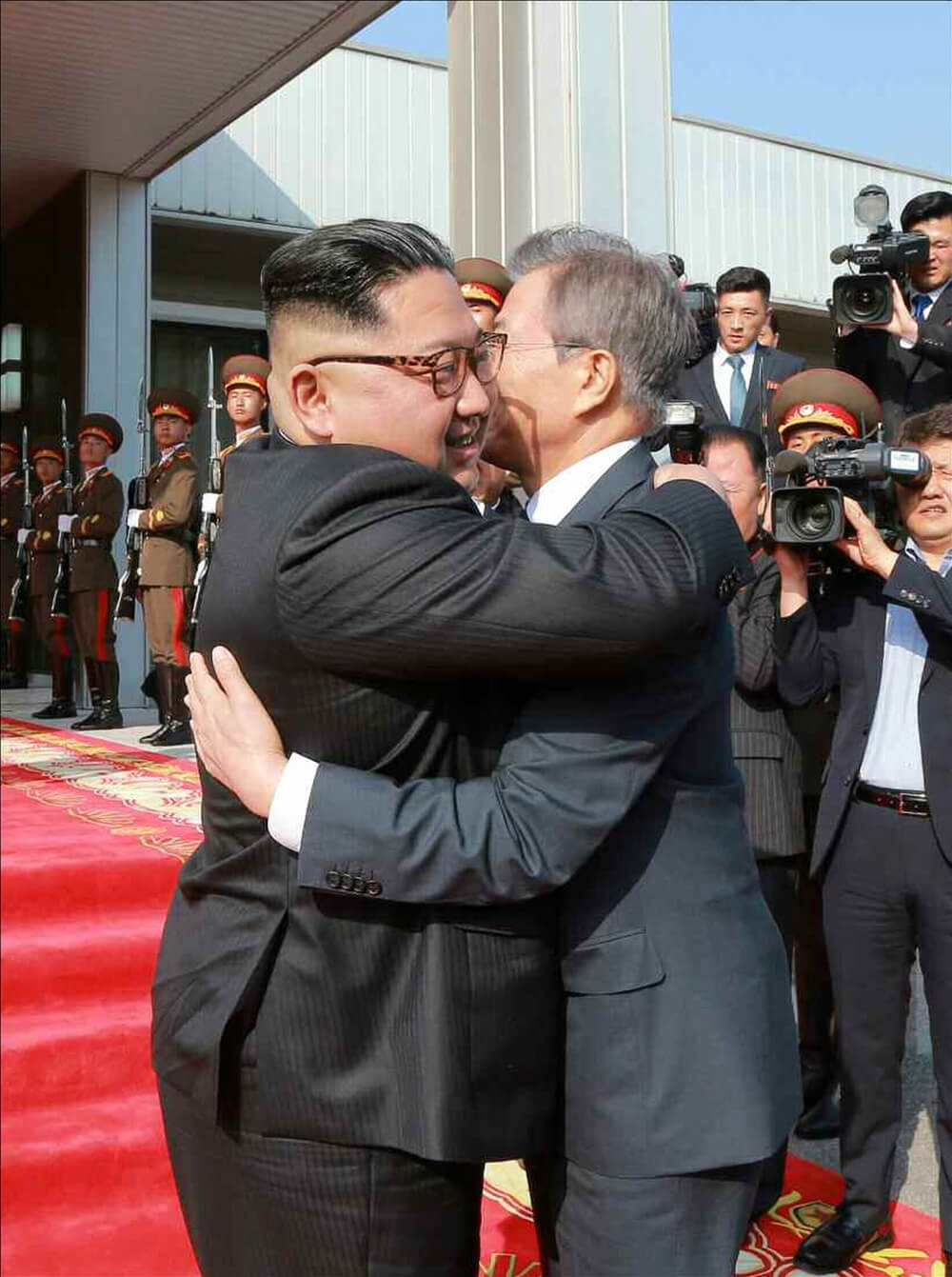
Following the “ surprise ” inter-Korean summit, contacts between the U.S. and North Korea took place quickly. Sung Kim, former U.S. the chief representative of the North Korean nuclear talks, met with Choi Sun-hee, North Korea‘s foreign ministry official, at the Tongil-Gak of Panmunjom from July 27 to 29 to arrange for North Korea-U.S summit. The two sides are said to have discussed intensively issues related to North Korea‘s denuclearization issue.
Ceasefire

Panmunjom Conference Rooms
Panmunjom is known for its blue single-story conference rooms: the Neutral Nations Supervisory Commission (NNSC) conference room or T1, the Military Armistice Commission (MAC) main conference room or T2, and the MAC’s small meeting room or T3. The initial “T” stands for “Temporary”, as the buildings were meant to be temporary, as no one at that time thought the armistice would last for more than 65 years. Armistice means ceasefire, not the end of a war.
However, the actual armistice was not signed here but 800 meters north - at “Peace Palace,” a wooden construction that was quickly built on the north side of the demilitarized zone. Ri Myung-je, father of the North Korean Minister of Foreign Affairs Ri Yong-ho, who visited Panmunjom on this occasion, was the North Korean journalist who photographed the signing ceremony of the armistice on July 27th 1953.
The current conference rooms were newly constructed in the central section of Panmunjom in October of the same year, immediately after the armistice was signed. On top of the meeting table, there is a microphone and a connecting cable that divides the South Korean and the North Korean sides. Only during a meeting between the two sides, or when either side is using it, can the participants move freely inside the building. A total of 460 MAC conferences took place here. Authorities of the two Koreas also met a total of 156 times, which is significantly high when compared to the 11 times at Freedom House, 94 times at Peace House, 12 times at Panmungak (on the North Korean side), and 87 times at Unification Pavilion (on the North Korean side).
Unconverted long-term Prisoners Return

The NNSC conference room was also used as a path for repatriation. On March 19th, 1993, Ri In-mo, an unconverted long-term prisoner was handed over to North Korea in that conference room. It was the first case of handing over an unconverted long-term prisoner back to north. He participated in the Korean War as a war correspondent and later became a North Korean partisan. He was arrested in 1952 and served 34 years in prison. On September 2nd, 2000, 63 unconverted prisoners were handed over to North Korea in the NNSC conference room. The South Korean government repatriated those prisoners by issuing them a visitor’s pass to North Korea and permanently extending the duration of their visit.
The Axe Murder Incident
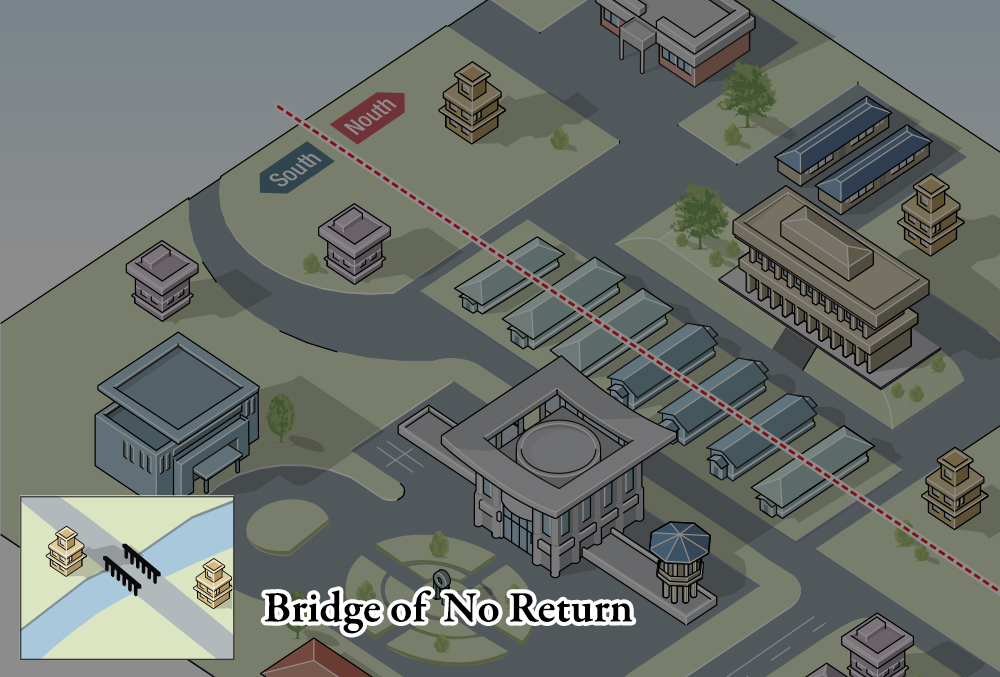
The Axe Murder Incident
On August 18th, 1976, near the UN’s 3rd guard post called the “Bridge of No Return”, two United States Army officers were killed by North Koreans with axes.
The officers were supervising the cutting down of a poplar tree that was blocking the view of a North Korean guard post. North Korean soldiers requested they stop cutting down the tree, but the U.S. soldiers continued working and 30 North Korean soldiers killed Captain Bonifas and First Lieutenant Mark Barrett with axes. In response, the U.N. forces launched Operation Paul Bunyan, in order to completely cut down the tree, and the South Korean and the U.S. authorities prepared for a full-scale war by increasing their readiness level to DEFCON 2. The U.S. Army deployed 5 additional warships to the area including an aircraft carrier. The U.S. military stationed in Japan also prepared for immediate commitment. The poplar tree was successfully cut down without resistance of the North Korean Army.

The war crisis was averted as Kim Il-sung directly expressed regret. After this incident, the military demarcation line was drawn through the Joint Security Area. Until then, it was literally a joint security area, where a mix of U.N. forces personnel and North Korean Army personnel stood guard. However, in order to prevent accidental conflict, they divided the guard areas between the south and the north and also shut down the “Bridge of No Return” after this incident.
Crew of USS Pueblo Returns
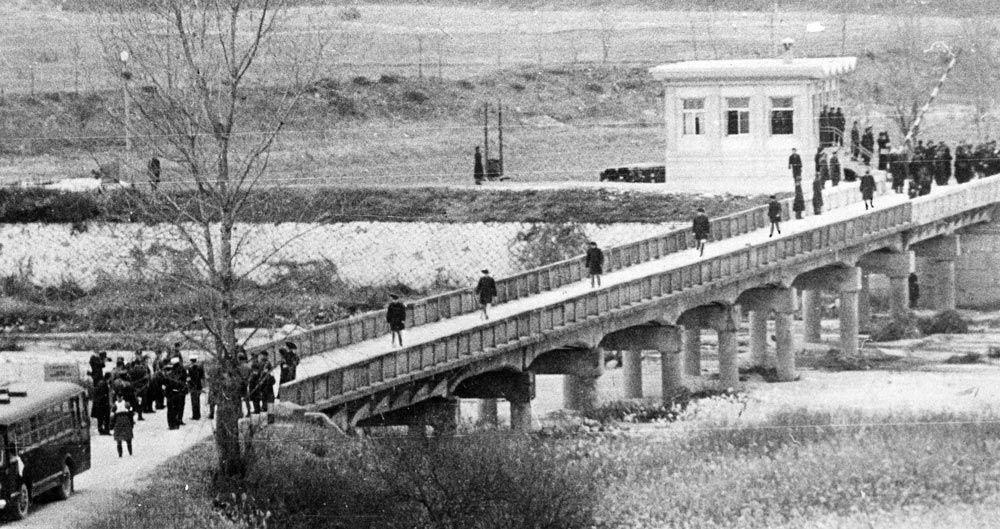
Eighty-two crewmembers of the USS Pueblo (AGER-2), a research ship for the U.S. Navy that was captured and held by North Korea, returned through the “Bridge of No Return” in Panmunjom on Dec 23th 1968. Pueblo was captured by the North Korean military in the East Sea off Wonsan, during which one of the crewmembers was shot to death. The U.S. deployed three aircraft carriers to the East Sea and began secret negotiations on February 2nd. They reached an agreement for the crew’s return after 30 meetings. North Korea moved Pueblo from the Port of Wonsan to the Taedong River in 1999 and has since turned the ship into an Anti-American propaganda facility.
A 30-minute Shooting
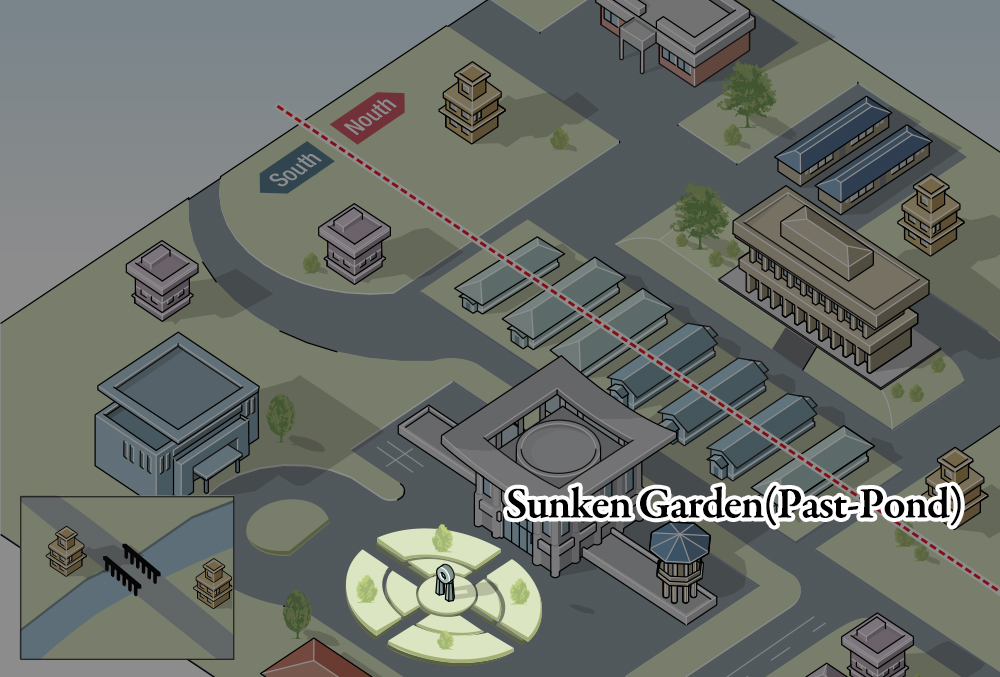
Matuzok, a Soviet Tour Guide, Defects
On November 23rd, 1984, a shooting occurred in Panmunjom. It all started when Vasily Yakovlevich Matuzok, a Soviet tour guide, defected to South Korea. He was photographing a military armistice commission meeting and during a chaotic moment, crossed the military demarcation line between the conference hall buildings. The North Korean military opened fire in order to stop him but failed. Soon, 17 North Korean soldiers crossed the military demarcation line, went 150 meters south to Sunken Garden, and engaged in a confrontation. Korean and U.S. soldiers promptly responded to the shooting - especially because the protocol for combat had been reinforced since the axe murder incident in 1976. At that time, U.S. Secretary of State Henry Kissinger looked at the photos of the site of the incident and allegedly said enraged, “Two were killed. Why aren’t there North Korean bodies? Shouldn’t we have shot North Koreans with handguns?

The shooting that was triggered by Matuzok’s defection lasted for 30 minutes and killed one South Korean soldier, 3 North Korean soldiers, and wounded one U.S. soldier. As the damage became significant, the North Korean military called for a ceasefire and said they would retreat after recovering the casualties. Korean and U.S. forces accepted and the shooting ended. The North Korean Army came to recover the casualties and returned to north. Matuzok, who came to Panmunjom, eventually sought asylum in the U.S.
Lim Su-kyung, a Civilian, Crosses the Line
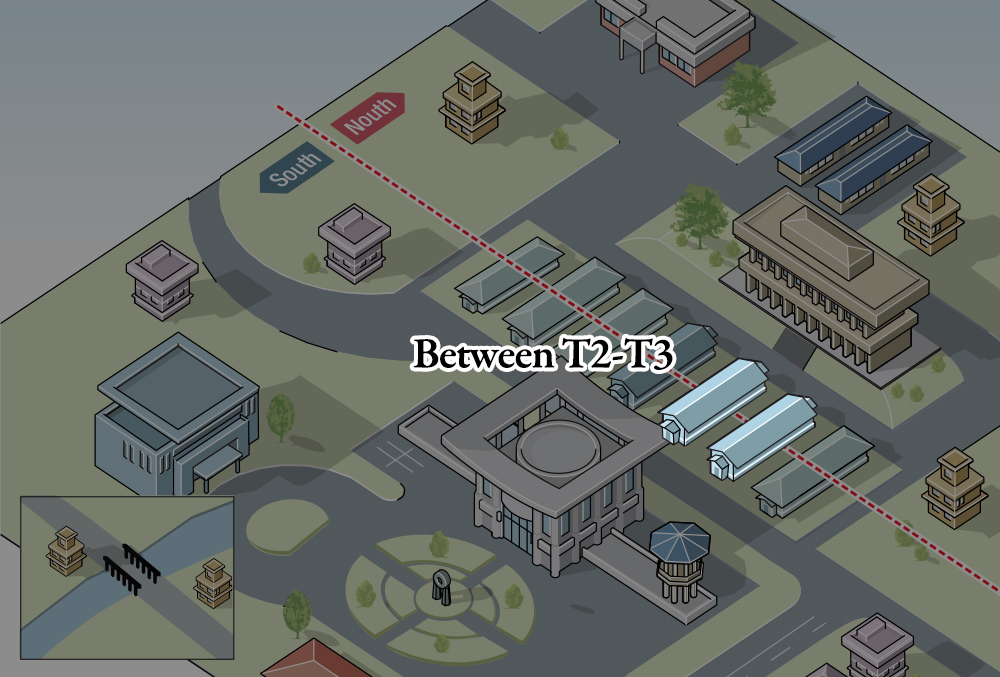
Lim and Moon Kyu-hyun Return to Panmunjom
Lim Su-kyung, a student at Hankuk University of Foreign Studies, and Rev. Moon Kyu-hyun returned to Panmunjom on August 15th 1989 after visiting North Korea to participate in the Pyongyang Festival. They arrived at the front of Panmungak on the North Korean side, gave a speech for 15 minutes, and walked across. In Panmunjom, there is a concrete curbstone 5 centimeters high and 50 centimeters wide placed between the MAC’s main conference room (T2) and the MAC’s small conference room (T3) and works as the military demarcation line. The area between the curbstone and the road is covered with gravel. No one except the security forces can enter this area. Lim and Rev. Moon were recorded to be the first civilian to cross through Panmunjom since the division of the peninsula.
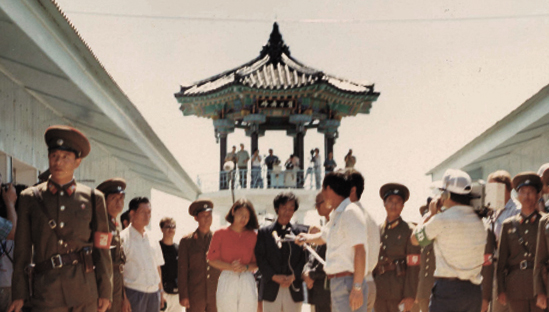
Lim left the country on June 21st and went through Tokyo, West Berlin, and Moscow to arrive in Pyongyang on the 30th. Lim, after crossing Panmunjom back to the South Korean side, was arrested by authorities for violating the National Security law and was sentenced to five years in prison but was released on parole after 3 years and 5 months. Later, in 2012, she served as the 19th congresswoman, working as a proportional representative of the Democratic Unionist Party (currently the Democratic Party of Korea). Im Jong-seok, Chief of Staff to President Moon and Chairman of the Preparation Committee for the recent inter-Korean summit, was the 3rd chairman of the National Council of Student Representatives at that time and was deeply involved in the process of Lim’s visit to North Korea.
Former President Jimmy Carter Visits North
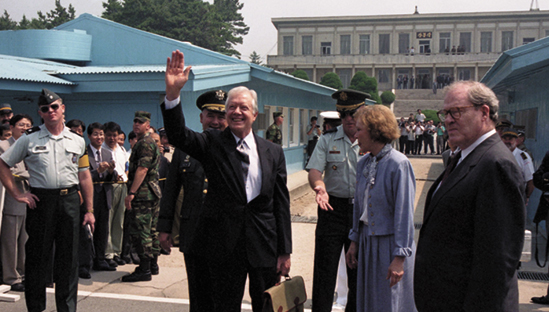
On June 15th, 1994, U.S. President Jimmy Carter went through Panmunjom to visit North Korea and returned using the same route three days later on the 18th. As a mediator during the 1st North Korean nuclear crisis, he met with Kim Il-sung and discussed nuclear issues. Based on that discussion, the U.S. and North Korea reached an agreement in Geneva in October of the same year, including a halt of nuclear development and their supply of light-water reactors.
Remains of Armed Spies Returned

On December 30th, 1996, the bodies of 24 agents of a North Korean intelligence agency were handed over to North Korea in Panmunjom. It was the first handover of bodies between the two Koreas. The agents were returning to North Korea in a Shark-level submarine after working as operatives on the eastern coast but the submarine became stranded, leading to their infiltration of the inland on September 18th. A search for the infiltrators started after a report from a cab driver. As a result, one of the North Korean agents was captured alive, 24 were shot to death, and one fled to North Korea after crossing the truce line. For this operation, 40,000 members from the military, police, and reserve forces were mobilized. North Korea expressed regret on the 29th, a day before the return of the remains and promised that such an incident would not happen again.
1001 Cows Headed to North

Hyundai Founder Chung, Crosses Border with Cows
On June 16, 1998, Hyundai’s honorary chairman Chung Ju-yung visited North Korea by crossing Panmunjom with 50 trucks carrying 500 cows. On October 27th of the same year, he visited North once again with 501 cows. Dozens of white trucks with the Red Cross logos entered North Korea through the road on the right side of the conference room. Chung passed the NNSC conference room and crossed the military demarcation line. Chung’s visit to North Korea laid the foundation for exchange and collaboration between the two Koreas. During his 2nd visit, North Korean leader Kim Jong-il visited Baek Hwa Won Hotel where Chung was staying and they quickly reached an agreement for the Mt. Kumgang tourism project.

Chung was originally from North Korea. He ran away from home and moved to South Korea when he was 17 with 70 won he stole from his father, who made that money by selling a cow. He founded Hyundai Group. Hyundai Asan and the North Korean Asia-Pacific Peace Committee completed an indoor stadium in Pyongyang in 2003, and named it “Ryugyong Chung Ju-yung Gymnasium”, by combining Ryugyong, the old name of Pyongyang that means “a city full of willow trees” with Chung’s name.
Kim Jong-un Visits Panmunjom

North Korean Leader Kim Jong-un Visits Panmunjom
North Korean leader Kim Jong-un has visited Panmunjom on March 4th 2012. The visit drew attention because it was only 3 months after his succession to power following the death of former leader Kim Jong-il in December of the previous year. From the top of Panmungak, he looked over South Korea through binoculars. He mentioned that South Korea is in the middle of joint military training with the U.S. and said, “our front guards in Panmunjom have always had confrontations with the enemy, and we always need to be in maximum readiness.” He also visited the monument that has an inscription of Kim Il-sung’s last handwritings and said, “If a fight occurs, I will make them sign the statement of surrender, not armistice.”
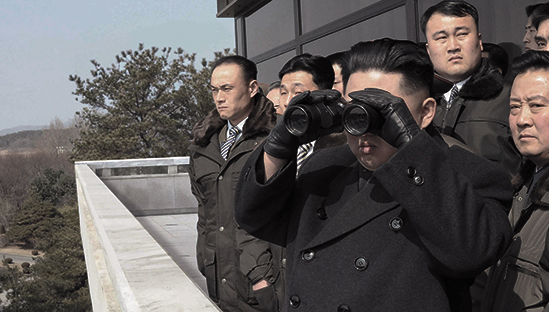
This parallels his father Kim Jong-il’s visit to the same monument on November 24th 1996, during which he emphasized the need to get a surrender statement, not an armistice.
A Soldier Risks His Life to Defect
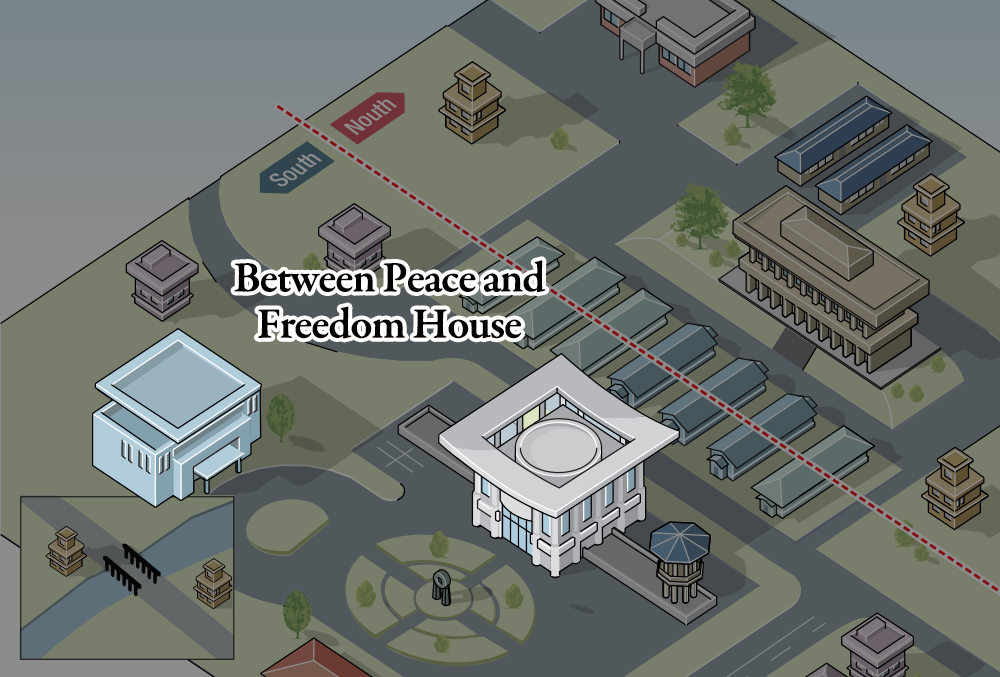
A North Korean Soldier‘s Dramatic Escape
On November 13th 2017, Oh Chong-song, a North Korean private, defected by crossing Panmunjom. He drove a Jeep across the “72-Hour Bridge” and arrived at the front of the military demarcation line. North Korean guards detected this unusual activity and started chasing him. When the Jeep became stuck in a ditch, Oh Chong-song got out of the Jeep and ran south, narrowly escaping the chase. A security camera captured footage of the North Korean guards crossing over the military demarcation line to the south side in order to chase him and then turning back afterwards.

Oh Chong-song, shot, was laying on the grass near Freedom House until he was transported by the South Korean military. Surgeon John Cook-Jong Lee of Aju University, who had treated Captain Seok Hae-gyun’s injury from Operation Dawn of Gulf of Aden in 2011, performed an emergency operation on Oh Chong-song and saved his life. In order to prevent future defection, the North Korean army planted trees in the ground where Oh Chong-song drove the Jeep through and installed a gate on the 72-Hour Bridge.